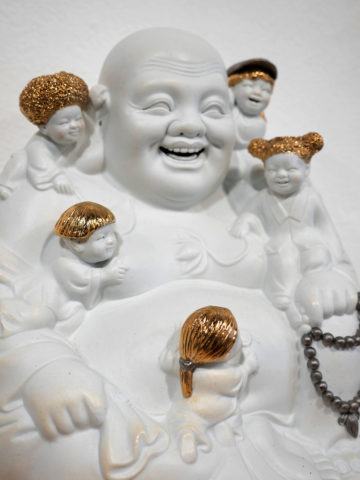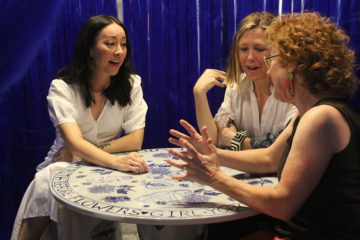On a recent trip to China, artist Jennifer Ling Datchuk visited a shop in Shanghai that offers eyebrow tattooing. Women can choose from a variety of brow shapes posted on the wall, from thick to thin, steeply arched to more natural. Datchuk was struck by the fact that each design was named for a Disney princess: the Sleeping Beauty, the Cinderella. It was just one of countless examples of the dominance of Western beauty standards that she saw on her travels, alongside skin-lightening creams and wigs made of human hair in every color.
“I always saw in my work how identity can be manufactured,” she said. “When I was in China, I met a hair dealer.” Hair dealers travel across rural China, buying ponytails that eventually make their way to wigs in the United States and elsewhere. “Think of how these were extensions of the body, commodifications of women. Women have been sold all over the world.”
Now living in San Antonio, Datchuk grew up in New York City with a first-generation Chinese immigrant mother and a second-generation Russian and Irish immigrant father. She recalls feeling different as a child, as though “part of a third culture that exists on its own.”
In Truth Before Flowers, her new exhibit at Women & Their Work in Austin, Datchuk explores ideas of multicultural identity, femininity and the performance of gender. The 16 pieces on display through July 25 include ceramics — Datchuk’s specialty — as well as photography, textiles and sculpture.

Many of the artworks are playful and inviting even as they interrogate cultural norms. “Golden Girls” is a traditional laughing Buddha sculpture, with smiling children gathered around the chubby deity, but Datchuk has gilded the children’s hair in glossy gold. One has an Afro; a second, a pair of cats’ ear buns. Another piece, “Don’t Worry Be Happy,” superimposes two pink smiley faces over an old-fashioned porcelain plate. Cheerful or creepy? It could be read either way.
Datchuk is fascinated by the duality of porcelain. “A lot of porcelain is associated with fragility,” she said. “I think one of the conversations that gets far removed from porcelain is that it’s everywhere, and it’s actually very strong.” The piece in the show that speaks to this contrast most directly is “One Tough Bitch,” an eye-catching photo of a woman’s abdomen with porcelain shards scattered atop it.
Datchuk recalls a time when women’s craft, such as pottery and textiles, were taught as a way to keep women busy in the domestic sphere and keep their voices outside of public spaces. “I’m using that today to speak out about the big movements [like #MeToo] and how women have a desire to speak now,” Datchuk said.
The largest piece in the show, “Babe Cave,” continues the theme of women’s voices. In the center of the gallery hangs a large circular curtain made with fake blue hair and porcelain beads. The beads contain cryptic messages from people all over the world, such as one from Germany that states “only a sausage has two ends” and another one from Finland with the handwritten words “one potato at a time.”

Inside the circle, visitors can sit at a porcelain table and chairs. Datchuk made them in Jingdezhen, China, where she collaborated with a table factory and spent three days painting with the owner’s family. Though the colors are traditional blue and white, she’s replaced classic floral or nature scenes with hearts, peaches, chrysanthemums and the Venus of Willendorf, among other feminine symbols. Along with the imagery are words of affirmation (“GIRL YOU CAN”) to encourage visitors to walk into the cave, come to the table and have conversations regarding girlhood and womanhood.
Different shades of women’s skin tones are explored on the south wall of the exhibit. One piece is an assortment of prize ribbons sculpted with slipcast Laguna porcelain. This artwork, called “G.O.A.T Girls,” is in skin tones ranging between “cool blush” and “African American.” The prize ribbon shape calls into question the idea that any skin tone is to be prized above others.
Above all, Datchuk hopes that people who view her art continue to ask questions and come away with a sense of empathy. “I hope that people are really seeking truths in their experiences and how they relate to others,” said Datchuk. “Because this isn’t gonna get easier, but how can we help each other?”







